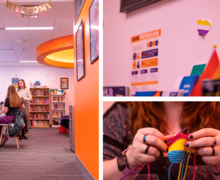Syracuse University researchers continue to further gravitational wave research
Will Carrara | Contributing Photographer
Syracuse University physics professors Peter Saulson, Stefan Ballmer and Duncan Brown contributed to the discovery of gravitational waves earlier this year.
Faculty members in Syracuse University’s School of Information Studies have teamed up with universities and a planetarium to advance the search of gravitational waves with a new tool.
Gravity Spy, officially launched on Oct. 12, is a science project that allows the general public to get involved in scientific research by going to gravityspy.org and sifting through images from instruments to classify them as certain types of glitches in the astrophysical data caused by sensitivity in the detectors.
SU physics professors Peter Saulson, Stefan Ballmer and and Duncan Brown contributed to the discovery of gravitational waves earlier this year.
Kevin Crowston, a distinguished professor of information science; Cartsen Oesterlund, an associate professor and director of information management and telecommunications and network management; and Ph.D. candidates Mahboobeh Harandi and Corey Jackson Jr. at SU are part of a group of about 15 people that also draws from California State University, Fullerton, Northwestern University and the Adler Planetarium who are working on Gravity Spy. The group was awarded a three-year grant of nearly $1 million across the four institutions from the National Science Foundation.
Volunteers have begun to make an impact using Gravity Spy, as one citizen scientist already identified a new type of glitch during beta testing. Crowston said citizen scientists are often motivated to participate in projects like this because they feel like they’re getting a peek backstage at science as it is happening and are able to see how the system works behind the scenes, rather than just reading a newspaper article about it later on.
“Citizen science is not new, but new online tools like Gravity Spy have facilitated increased use of citizen science,” Jackson said. “Basically, it’s an approach where scientists who need to get an insane amount of data analyzed in a reasonable amount of time place the data on websites like Zooniverse and have members of the public go in and help.”
Joshua Smith, an SU alumnus and associate professor of physics at California State University, Fullerton, is a member of the Laser Interferometer Gravitational-Wave Observatory, a scientific collaboration working on the search for gravitational waves. He said the public’s contribution to gravitational wave research is important because it can help improve the quality of the LIGO data.
“Gravity Spy helps us to quickly identify all of the different types of interesting issues that happen in the LIGO data, and that helps us to track down and eliminate problems in the detector so we can more clearly see the gravitational waves,” he said.
Gravitational waves were predicted by Einstein 100 years ago in 1916 and correlate to his theory of relativity. Just like light has waves of electromagnetism, there are waves of gravity. Taking any two objects with mass, such as two fists, and shaking them around will generate gravitational waves, Smith said.
When the two black holes collided that allowed for the discovery of gravitational waves, they sent waves across the universe from a billion light years away and when they reached earth, the LIGO detectors were able to measure them.
The detectors, located in Livingston, Louisiana, and Hanford, Washington, present complex data due to sensitivities in the machines themselves as well as factors from the local environment, like the wind blowing or ground shaking, Crowston said. The gravitational waves from outer space are expected to arrive around once a month, and non-astrophysical data is recorded by the detectors every two to three seconds.
The team at Northwestern curates images from the raw gravitational data, changing it into the image form before they’re sent off to be viewed by citizen scientists. One important part of the project is looking at the interface of computers doing machine learning and humans processing with our visual and mental capacities, Jackson explained.
“It’s kind of a continual organic process,” said Scott Coughlin, a project member from Northwestern. ”We have about 20 different categories of glitches, and citizen scientists go through and sort images into those categories. Then there’s images that don’t yet have a label that fits them, and what humans can do that computers aren’t as good at is they can identify what makes new glitches similar. Then with machine learning, based on user input, models can scan images and sorting can go a lot faster.”
Anyone can participate in the project. Zooniverse has about 50 different projects and 1.5 million citizen scientists as of now and Gravity Spy itself has more than 3,200 registered volunteers, who have done almost 444,000 classifications, according to their respective websites.
Jackson said it’s interesting to get people who have no real background in astronomy or physics involved in doing scientific research.
The Syracuse team is looking at developing new features for collaboration where users can discuss the images with others, he said. Those include allowing people to curate collections of images to aid in the creation of new glitch classes and facilitating live sessions with scientists from the LIGO project to highlight interesting developments in the project.
“This is a new type of astronomy that allows us to see things we couldn’t see at all with just telescopes and just light; it’s a completely new way to look at the universe,” Smith said. “I hope Gravity Spy gives the citizen scientists and the public in general a deeper appreciation for and understanding of the way that science is done.”
Published on November 6, 2016 at 11:09 pm





